Where else can you find the skinny on this many Minor League ballpark changes? Below, you’ll find descriptions of the parks that are opening or changing in 2015, as well as developments that may — or may not — point toward new parks in future years. If you want to review the parks that opened in the affiliated Minors in 2014, click here.
Changes for 2015
BILOXI This Gulf Coast city had long planned to build a new ballpark, but Hurricane Katrina and then the BP oil spill ground those plans to a halt. However, with the State of Mississippi contributing $15 million from BP oil-disaster money and Biloxi’s city council committing to issue bonds on another $21 million, a $36 million pricetag for the new stadium was set and the project was back on. The location was set, an architect (Dale Partners Architects of Biloxi) began working on a design and a potential ownership was identified. The franchise to be relocated was the Huntsville Stars, who finished dead last in attendance in the Southern League in 2012, 2013 and 2014. Biloxi’s City Council gave the final approval needed to move forward on the project on October 8, 2013, voting 5-2 in favor, paving the way for the ballpark to open in 2015. Once ground was broken in 2014, there were a series of delays that prevented MGM Park from opening on time in April 2015. Then, after the team announced that the inaugural game in the new park would be June 6 and they started selling tickets, the City announced (without informing the team) that the park would *not* open on June 6, and that it might be August before it would be done. A flurry of round-the-clock activity ensued, and a fairly finished ballpark did indeed open on June 6. Check out our in-depth review of the park, including three dozen photos.
 |
| Dale Partners Architects prepared this rendering for the City of Biloxi. |
MORGANTOWN This city in northern West Virginia wants to follow the example of State College, PA. West Virginia University’s baseball program needed a new park to accommodate their conference games in the Big 12, because 32-year-old Hawley Field wasn’t sufficient. They figured that after the college season is over, it would make a lot of sense for a New York-Penn League team to play its games there … just like in State College. The energetic Director of Athletics at WVU (at the time) was adept at making things happen, and he pushed for a new ballpark will be built next to shopping area on a hilltop north of the city. The architect who created the first renderings for the park is Designstream, LLC of Pittsburgh. Their rendering is shown on the left below (courtesy of Kevin Turkall of Designstream). Construction started (below right) on a hillside that provides a wonderful view of the
valley and parts of WVU’s campus. The President of Minor League Baseball, buoyed by Monongalia County approval of the project, even conducted a press conference in Morgantown on March 26, 2013 to announce that a team from the NY-Penn League will play in this new park starting in 2015.
It took a special session of the State Legislature to pass Monongalia County’s proposal to create a Tax Increment Financing (TIF) proposal, but that happened, and West Virginia’s governor then signed it into law during a WVU baseball game on April 30, 2013. Groundbreaking was October 17, 2013, and the first NY-Penn League game there will be June 17, 2015, and we’ll be there to cover it. The team is the former Jamestown Jammers, who are now called the West Virginia Black Bears. We covered their first game and wrote an in-depth review of the ballpark, complete with 38 photos. It was also our 2015 Ballpark of the Year.
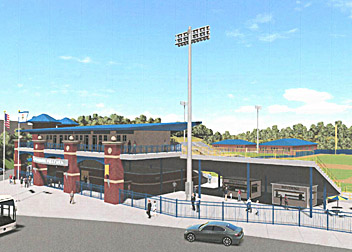 |
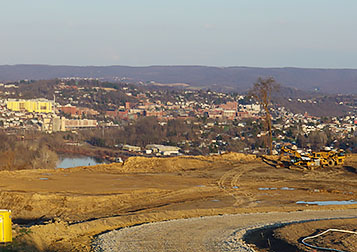 |
NASHVILLE An idea with tremendous potential fell completely apart in 2007, but there is hope of it making a comeback. After seeing new ballparks appear in Memphis, Jackson, Chattanooga and near Knoxville, the other major city in Tennessee wanted a new facility, too. On Feb. 7, 2006, Nashville’s Metro Council took a huge step in making this a reality by approving an ambitious development project on city-owned land at the former site of the Thermal Transfer Plant, along the banks of the Cumberland River near downtown Nashville. The centerpiece was an HOK-designed ballpark, which would have cost $43 million to build. The underlying financial arrangements involved the team borrowing $23 million from a consortium of a dozen Tennessee banks, while the other $20 million would come from a combination of the developer, who would’ve constructed retail space and condos next to the ballpark, and from tax-increment financing. In addition to providing the land, the city committed $500,000 a year to help with the park’s operating costs. The Sounds of the Pacific Coast League had been hoping to move into the 12,500-seat facility in 2007 or 2008, but there were so many delays that the project was pushed back to 2009 … and then to “never.” The Metro government authority in Nashville finally ran out of patience with the team, and when a solid deal to finance and develop the project failed to materialize by a deadline of April 15, 2007, the government pronounced the project dead. Because baseball in Nashville deserves a facility as nice as the stadium for the NFL Titans and the arena for the NHL Predators, Nashville’s mayor resurrected talks, floating out three possible sites for a new park in November of 2009. The winning location is near the site of Nashville’s one-time baseball stadium, the famous Sulphur Dell. Populous did the design, and First Tennessee Bank signed on to be the naming-rights sponsor of the ballpark. The first game was held right on time on April 17, 2015, and we were there to cover it. See our in-depth review (with 43 photos) here.
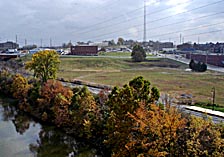 |
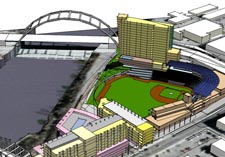 |
 |
| The site that was previously proposed for the Sounds’ new park was along the banks of the Cumberland River. In the center is the site plan showing the park and hotels/condos that were intended to surround it. When that all fell apart, a new plan to build on the northern side of downtown did come together. The new facility is called First Tennessee Park, and an early look at its design is above right (renderings courtesy of the Sounds). | ||
Changes for 2016 and beyond (or maybe never!). . .
AMARILLO This city in the panhandle of Texas is no stranger to affiliated baseball, as the Amarillo Gold Sox played in the Texas League until 1982. When city leaders started making plans to build a downtown ballpark to replace aging Potter County Memorial Stadium, which opened in 1949 (and looks like it), everyone assumed the park would be for an independent league team. Not so fast. The city and a consultant decided to explore the possibility of bringing the Texas League back to town, and as luck would have it, the San Antonio Missions might need to find a new home if Triple-A baseball moves there to play in a new downtown stadium. Stay tuned.
AUGUSTA The Green Jackets of the South Atlantic League appear on the verge of getting a new ballpark without even leaving their market. After a tentative plan for a park on the banks of the Savanah River in downtown Augusta fell through, the separate city of North Augusta appears to be close to constructing Project Jackson, which will include retail space, apartments, office buildings and, of course, a baseball stadium. A lawsuit filed by a resident of North Augusta delayed the start of construction, but it appears that things will start moving forward sometime during the second half of 2015. The ballpark would then most likely be able to host the Green Jackets in 2017. The team’s current home, quaint Lake Olmstead Stadium, opened in 1995.
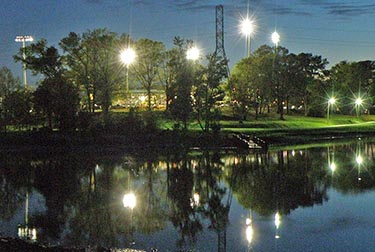 |
| Lake Olmstead Stadium is located in one of the most picturesque settings in the Minors. |
BAKERSFIELD The Cal League’s Bakersfield Blaze have badly needed a new ballpark to replace aging Sam Lynn Ballpark (which faces directly into the setting sun) for a very long time. Finally, with new owners on board, it looked like it would become a reality. Discussions with architects and developers took place, and a new park appeared to be on the horizon for 2015. It would’ve anchored a commercial development on the rapidly growing west side of Bakersfield. Alas, private investors couldn’t be convinced to provide the needed capital, and the team’s owners announced on October 7, 2013 that the plan was all but dead. This is a real shame, because San Lynn Ballpark is easily the worst facility in High-A baseball. This prompted the team to pursue a to-be-built park in Salinas, CA (see below).
 |
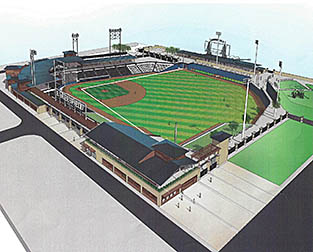 |
| This vacant land, with tumbleweeds collecting along the fence, is where the ballpark would’ve been built. On the right is a possible design for the park had investment dollars been raised. (courtesy of the Blaze). | |
COLUMBIA The capital city of South Carolina had an affiliated Minor League team for years, but when their dilapidated old park just didn’t measure up any more, the allure of a new park in Greenville, SC drew the South Atlantic League team upstate. Columbia’s college baseball program, the University of South Carolina, jumped to national prominence, and a lot of energy went into improving their facilities, while none went into a new park for a pro-baseball team. After a couple of aborted attempts to finance the construction of a new pro park, that is about to change. Hughes Development Corp. acquired the 165-acre site of the former South Carolina State Hospital near downtown Columbia, and a pro ballpark will be the centerpiece for a mixed-use commercial project. The City Council approved a “venue development agreement” on June 17, 2014, and then on August 19, 2014, they officially hired Populous to design and oversee the construction of the park. This paved the way for an October 2014 construction start, with the ballpark being completed by March 2016. The $35-million facility will be the new home of the Savanah Sand Gnats of the South Atlantic League. The Columbia Fireflies will begin play in the new park in April 2016.
FREDERICKSBURG This growing Virginia city tried to take advantage of two other municipalities dropping the ball. Hagerstown, MD, the longtime home of the Sally League Suns, has had multiple opportunities to build a new park to replace decrepit Municipal Stadium, but hasn’t. Nearby Winchester, VA planned to swipe the Suns to play in a proposed complex, but that deal stalled. In swooped Fredericksburg with a solid plan to build an ambitious complex of youth fields and a pro ballpark. The Suns, who’ve stated in the past that they would leave the team nickname behind in Hagerstown if they ever moved, hoped to be in Fredericksburg by 2015, but an $18-million funding gap doomed the project all together. The Suns were so sure that they were going to move that a lawsuit has been filed over the collapse of the Fredericksburg project. The latest news is that Spotsylvania, VA could be the franchise’s destination.
HAGERSTOWN Municipal Stadium in Hagerstown, MD is certainly one of the lesser facilities in Class A baseball. The Suns of the South Atlantic League have been working on obtaining a new facility since the 1990s. When prospects looked bleak, the City of Winchester, VA came calling to entice the team to move
to a to-be-built facility in Winchester, but no solid financing package could be put together. Fredericksburg, VA (see above) had looked like the destination for the team, but the plans fell apart completely. If the inevitable does happen and the franchise moves, that doesn’t mean that Hagerstown would lose pro baseball forever. It is possible that the city could still build a new park, but perhaps one not as ambitious as what would’ve been needed by the Suns. If that happens, a NY-Penn League team could move to town.
HARTFORD The capital city of Connecticut has been without pro baseball since 1952, although the Eastern League has been playing just 13 miles away in New Britain. Well, the New Britain Rock Cats announced on June 4, 2014 that they would be making that 13-mile move to the north side of downtown Hartford as soon as their 20-year lease at New Britain Stadium was up, following the 2015 season. Hartford, in turn, is building a $60 million, 9,000-seat ballpark for the team to be ready for the 2016 season. Pendulum did the site studies for the City, and is behind the design of the ballpark. Ground was broken for the stadium on February 17, 2015, but a series of construction delays, cost overruns and controversies involving the developer will force the team to play only road games for at least the first month of the 2016 season. The team will be known as the Hartford Yard Goats (no, I’m not making that up) and the stadium will be called Dunkin Donuts Park.
HUNTSVILLE The mayor of Huntsville, AL understands that his city is losing its Southern League’s Stars, who for the past three decades have played at Joe W. Davis Municipal Stadium. Not only is it the oldest (and in our opinion, hands-down the worst) stadium in the league, it also draws by far the fewest fans in all of Class AA baseball. The mayor has proposed a new ballpark that would be closer to downtown. The tricky part, of course, is how to pay for it, and it could very well necessitate the sale of the current stadium. No timetable for a new park has yet been pinned down, but it is badly needed if any franchise is going to come to this market to replace the Stars.
LAS VEGAS In a city full of bright lights and exciting entertainment, Cashman Field is a poor excuse for a Triple-A ballpark. When new owners took over the franchise, they made building a new park an extremely high priority, most likely in the western planned community of Summerlin, which seems to be amenable to the plan. Populous has been developing ideas for a park there, and here’s hoping it happens sooner rather than later.
MELBOURNE Since Space Coast Stadium in Viera, Florida will be losing the Nationals as spring-training tenants, the park’s regular-season team, the Brevard County Manatees of the Florida State League, is looking for a new home, too. The most likely destination is downtown Melbourne, which is conveniently also in Brevard County. A parcel of land along the water is being assessed as a possible place to build a new ballpark, although it would be a very tight fit. If it comes about, 2017 is the likely opening date.
PROVIDENCE When new owners (which included the Boston Red Sox with a minority share) took over the Pawtucket Red Sox of the International League, they met with the mayor of Pawtucket to let him know they intended to move the team to a city with a brand-new ballpark. When the ownership group met with City officials in nearby Providence the following day, it appeared that Rhode Island’s capital city would be the destination. The owners intend to pay to build the park, but the City would need to provide the land and infrastructure. The process of sorting all of this out will no doubt take a couple of years.
RICHMOND I can only categorize the situation that led to the departure of the Richmond Braves as a complete breakdown within the city government of Richmond, Virginia. Warned repeatedly by the Atlanta Braves that its Triple-A baseball team needed a better facility than the city’s clam-shaped ballpark (called The Diamond), Richmond failed to act. A number of proposals were floated, including constructing a brand-new stadium in various parts of town, but ultimately the discussion kept coming back to the uninspiring location of the current park. From the perspective of an outsider looking in, it seemed to me the city made the ballpark an extremely low priority, and the brass of the team in Atlanta must’ve run out of patience — in much the same way as they did with Greenville, SC when they yanked their Double-A team out of South Carolina and into a brand-new stadium in Pearl, Mississippi. Following that template, the Braves announced on January 15, 2008 that their Triple-A team would leave Richmond following the 2008 season to move to a to-be-built park in Gwinnett County, just northeast of Atlanta. This left the attractive Richmond market open for another pro team, but not another Triple-A franchise. Double-A franchises then pushed to take over that territory — and the one selected was the team formerly known as the Connecticut Defenders. The Eastern League franchise changed their name to the (really) Flying Squirrels and moved into the The Diamond in 2010, all the while continuing the drumbeat for a new park. After talk that this might happen out in Richmond’s suburbs, discussions began to focus on parcels of land adjacent to The Diamond, and then shifted back to the spot mentioned prominently earlier: Shockhoe Bottom, just across I-95 from downtown, and just a few blocks from the State Capitol. One main obstacle: the desired site is made up of a lot of smaller parcels, all with different owners. Assembling the pieces under City control is proving challenging — but it’s worth the effort, because this is by far the most intriguing site for a new park. It appears that if a new facility is constructed there, the soonest the Flying Squirrels would move in would be 2016. Odell, the architecture firm that was chiefly responsible for Charlotte’s new showplace ballpark, is working with the City on designs.
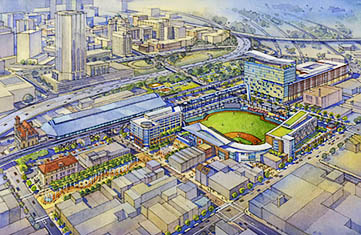 |
| Odell developed this site plan for the City of Richmond. |
SALINAS This California city is about 20 miles northeast of Monterey, and they appear to be serious about building a new ballpark for a Cal League team. There’s no firm timetable, but the Bakersfield Blaze want to move here. The owners of the Blaze even negotiated in earnest with a lumber company in Salinas that owned land (see image below) that would’ve made a good ballpark site. Alas, those efforts failed to bear fruit, but the Blaze is so intent on leaving Historic Sam Lynn Ballpark (easily the worst facility in High A baseball) that they are now assessing other sites in Salinas.
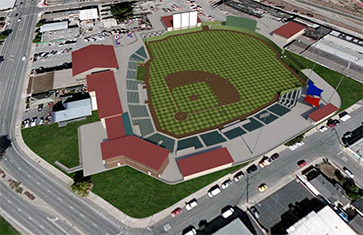 |
| The City of Salinas floated this graphic past local residents so they could see how the new park would be oriented. This site, though, failed to be available. |
SAN ANTONIO After being spurned as a Major League expansion market in the 1990s, there is now talk that this current Class AA market might move up to AAA if they build a downtown ballpark to replace 21-year-old Nelson Wolff Municipal Stadium. If that happens, the Texas League Missions would need to relocate.
SAN JOSE No, we’re not talking about the ballpark that the Oakland A’s would like to build near the city’s downtown. We’re talking about the San Jose Giants of the Cal League. They are in preliminary talks with the City about unused land at the Santa Clara County fairgrounds. The team’s current home, quaint Municipal Stadium, was built in 1942.
THE WOODLANDS Houston’s urban sprawl seems to be spreading in every direction. Nowhere is it more true than due north of the metropolis, especially in upscale suburbs like Spring and The Woodlands. At one point, the Astros had the opportunity to back a plan for their Triple-A team to play in the southwest suburb of Sugar Land, but they shortsightedly turned it down in the mistaken belief that it might rob attendance from Minute Maid Park. Into that vacuum leapt an independent minor league team that has had solid success playing in the brand-new ballpark that could’ve housed the Astros’ top farm team. The owner of the Astros isn’t going to make the same mistake again, this time electing to join forces with a developer who wants a pro ballpark to anchor a new development on a 2,000-acre tract in The Woodlands. Completion could be in 2016, and the Astros would have to find a PCL franchise to buy and relocate there. One rumor says that franchise might be the Astros’ one-time farm team, the New Orleans Zephyrs. Frankly, if a park is going to be built in The Woodlands, my guess is that it would be for an independent league team.
WILMINGTON A number of times over the years, we’ve included Wilmington, NC in our list of places about to build a new park. Many times, plans fell through … and now we have yet another example. There was a movement afoot for a downtown development that would include a marina, hotels, restaurants and a ballpark. Local media reported that the Braves were interested in locating a Minor League affiliate there. Since the Braves’ AAA, AA and low-A teams have permanent homes in fairly new ballparks, most assumed it would be the high-A Carolina League team (currently in Lynchburg) or the Rookie-level Apply League team (now in Danville, VA) that would move to Wilmington, with the former being the more likely scenario, which would then shift the Appy League team to Lynchburg. Wilmington was serious enough about this to hire National Sports Services to manage the project — after initially indicating Ripken Design would do the work. However, the plan fell apart when local voters overwhelmingly defeated an initiative to fund the park on November 6, 2012. Since then, there have been only modest attempts to resurrect the plan.
WINTER PARK With the Washington Nationals moving their spring training down the Atlantic Coast from Viera to Palm Beach County, the full-season Minor League team that plays in Viera (the Brevard County Manatees) are looking to move, too. We mentioned Melbourne as a possible landing spot, but significant conversations have also taken place between the Manatees and Rollins College in Winter Park, FL, a suburb of Orlando. If all of the financing can be finalized, a 2,500-seat ballpark with eight suites would be constructed on Rollins’ campus, and the college baseball team and the Manatees would share the park. The Orlando market has no pro baseball during the regular season currently … and it appears likely that this won’t change, as the Manatees have again moved their focus back to Melbourne.
WOODBRIDGE Woodbridge, VA is the home to the Potomac Nationals (formerly Cannons) of the Carolina League. It’s also home to one of my least favorite pro ballparks in the country (see my essay on A Bad Day at the Ballpark), Pfitzner Stadium. Time and time again, we’ve heard that Prince William County and the team were close to an agreement to built a badly needed new park, and time and time again, a new facility has failed to materialize. We heard rumblings in April of 2012 that a plot of land near I-95 might be donated for a new park, but it wasn’t until July 17th that a press conference was held announcing the details. Almost right across I-95 from Potomac Mills Mall was to be a $25 million ballpark and parking garage. The owner of the Potomac Nationals even announced that he would fund the ballpark construction. The plan originally called for the facility to be ready by opening day of 2014, but after numerous delays, there is uncertainty about whether a new park will happen at all. See the rendering (superimposed on an aerial photo) below. Rendering courtesy of the Potomac Nationals.
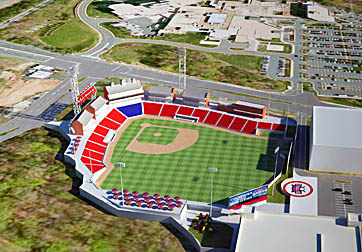 |